Free Dumps, Free Microsoft Dump
Free AZ-305 Dump
Question #61Topic 1
HOTSPOT
–
You have an Azure subscription that contains 50 Azure SQL databases.
You create an Azure Resource Manager (ARM) template named Template1 that enables Transparent Data Encryption (TDE).
You need to create an Azure Policy definition named Policy1 that will use Template1 to enable TDE for any noncompliant Azure SQL databases.
How should you configure Policy1? To answer, select the appropriate options in the answer area.
NOTE: Each correct selection is worth one point.

Correct Answer: 
Question #62Topic 1
You have an Azure subscription. The subscription contains a tiered app named App1 that is distributed across multiple containers hosted in Azure Container Instances.
You need to deploy an Azure Monitor monitoring solution for App. The solution must meet the following requirements:
• Support using synthetic transaction monitoring to monitor traffic between the App1 components.
• Minimize development effort.
What should you include in the solution?
- A. Network insights
- B. Application Insights
- C. Container insights
- D. Log Analytics Workspace insights
Correct Answer: B
Community vote distribution
B (100%)
Question #63Topic 1
HOTSPOT
–
You have an Azure subscription that contains the resources shown in the following table:

Log files from App1 are registered to App1Logs. An average of 120 GB of log data is ingested per day.
You configure an Azure Monitor alert that will be triggered if the App1 logs contain error messages.
You need to minimize the Log Analytics costs associated with App1. The solution must meet the following requirements:
• Ensure that all the log files from App1 are ingested to App1Logs.
• Minimize the impact on the Azure Monitor alert.
Which resource should you modify, and which modification should you perform? To answer, select the appropriate options in the answer area.
NOTE: Each correct selection is worth one point.
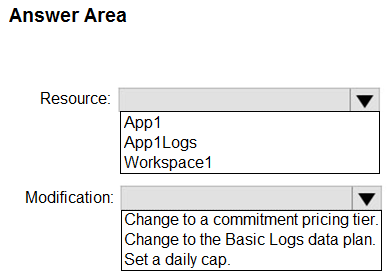
Correct Answer: 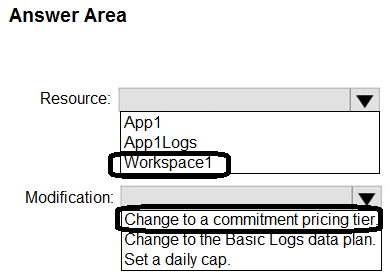
Question #64Topic 1
You have 12 Azure subscriptions and three projects. Each project uses resources across multiple subscriptions.
You need to use Microsoft Cost Management to monitor costs on a per project basis. The solution must minimize administrative effort.
Which two components should you include in the solution? Each correct answer presents part of the solution.
NOTE: Each correct selection is worth one point.
- A. budgets
- B. resource tags
- C. custom role-based access control (RBAC) roles
- D. management groups
- E. Azure boards
Correct Answer: BD
Community vote distribution
AB (100%)
Question #65Topic 1
HOTSPOT
–
You have an Azure subscription that contains multiple storage accounts.
You assign Azure Policy definitions to the storage accounts.
You need to recommend a solution to meet the following requirements:
• Trigger on-demand Azure Policy compliance scans.
• Raise Azure Monitor non-compliance alerts by querying logs collected by Log Analytics.
What should you recommend for each requirement? To answer, select the appropriate options in the answer area.
NOTE: Each correct selection is worth one point.

Correct Answer: 
Question #66Topic 1
HOTSPOT
–
You have an Azure subscription.
You plan to deploy five storage accounts that will store block blobs and five storage accounts that will host file shares. The file shares will be accessed by using the SMB protocol.
You need to recommend an access authorization solution for the storage accounts. The solution must meet the following requirements:
• Maximize security.
• Prevent the use of shared keys.
• Whenever possible, support time-limited access.
What should you include in the solution? To answer, select the appropriate options in the answer area.
NOTE: Each correct selection is worth one point.

Correct Answer: 
Question #67Topic 1
HOTSPOT
–
You have an Azure subscription. The subscription contains 100 virtual machines that run Windows Server 2022 and have the Azure Monitor Agent installed.
You need to recommend a solution that meets the following requirements:
• Forwards JSON-formatted logs from the virtual machines to a Log Analytics workspace
• Transforms the logs and stores the data in a table in the Log Analytics workspace
What should you include in the recommendation? To answer, select the appropriate options in the answer area.
NOTE: Each correct selection is worth one point.

Correct Answer: 
Topic 2 – Question Set 2
Question #1Topic 2
You have 100 servers that run Windows Server 2012 R2 and host Microsoft SQL Server 2014 instances. The instances host databases that have the following characteristics:
✑ Stored procedures are implemented by using CLR.
✑ The largest database is currently 3 TB. None of the databases will ever exceed 4 TB.
You plan to move all the data from SQL Server to Azure.
You need to recommend a service to host the databases. The solution must meet the following requirements:
✑ Whenever possible, minimize management overhead for the migrated databases.
✑ Ensure that users can authenticate by using Azure Active Directory (Azure AD) credentials.
✑ Minimize the number of database changes required to facilitate the migration.
What should you include in the recommendation?
- A. Azure SQL Database elastic pools
- B. Azure SQL Managed Instance
- C. Azure SQL Database single databases
- D. SQL Server 2016 on Azure virtual machines
Correct Answer: B
SQL Managed Instance allows existing SQL Server customers to lift and shift their on-premises applications to the cloud with minimal application and database changes. At the same time, SQL Managed Instance preserves all PaaS capabilities (automatic patching and version updates, automated backups, high availability) that drastically reduce management overhead and TCO.
Reference:
https://docs.microsoft.com/en-us/azure/sql-database/sql-database-managed-instance
Community vote distribution
B (100%)
Question #2Topic 2
You have an Azure subscription that contains an Azure Blob Storage account named store1.
You have an on-premises file server named Server1 that runs Windows Server 2016. Server1 stores 500 GB of company files.
You need to store a copy of the company files from Server1 in store1.
Which two possible Azure services achieve this goal? Each correct answer presents a complete solution.
NOTE: Each correct selection is worth one point.
- A. an Azure Logic Apps integration account
- B. an Azure Import/Export job
- C. Azure Data Factory
- D. an Azure Analysis services On-premises data gateway
- E. an Azure Batch account
Correct Answer: BC
B: You can use the Azure Import/Export service to securely export large amounts of data from Azure Blob storage. The service requires you to ship empty drives to the Azure datacenter. The service exports data from your storage account to the drives and then ships the drives back.
C: Big data requires a service that can orchestrate and operationalize processes to refine these enormous stores of raw data into actionable business insights.
Azure Data Factory is a managed cloud service that’s built for these complex hybrid extract-transform-load (ETL), extract-load-transform (ELT), and data integration projects.
Reference:
https://docs.microsoft.com/en-us/azure/storage/common/storage-import-export-data-from-blobs https://docs.microsoft.com/en-us/azure/data-factory/introduction
Community vote distribution
BC (97%)
Question #3Topic 2
You have an Azure subscription that contains two applications named App1 and App2. App1 is a sales processing application. When a transaction in App1 requires shipping, a message is added to an Azure Storage account queue, and then App2 listens to the queue for relevant transactions.
In the future, additional applications will be added that will process some of the shipping requests based on the specific details of the transactions.
You need to recommend a replacement for the storage account queue to ensure that each additional application will be able to read the relevant transactions.
What should you recommend?
- A. one Azure Data Factory pipeline
- B. multiple storage account queues
- C. one Azure Service Bus queue
- D. one Azure Service Bus topic
Correct Answer: D
A queue allows processing of a message by a single consumer. In contrast to queues, topics and subscriptions provide a one-to-many form of communication in a publish and subscribe pattern. It’s useful for scaling to large numbers of recipients. Each published message is made available to each subscription registered with the topic. Publisher sends a message to a topic and one or more subscribers receive a copy of the message, depending on filter rules set on these subscriptions.
Reference:
https://docs.microsoft.com/en-us/azure/service-bus-messaging/service-bus-queues-topics-subscriptions
Community vote distribution
D (91%)
9%
Question #4Topic 2
HOTSPOT –
You need to design a storage solution for an app that will store large amounts of frequently used data. The solution must meet the following requirements:
✑ Maximize data throughput.
✑ Prevent the modification of data for one year.
✑ Minimize latency for read and write operations.
Which Azure Storage account type and storage service should you recommend? To answer, select the appropriate options in the answer area.
NOTE: Each correct selection is worth one point.
Hot Area:
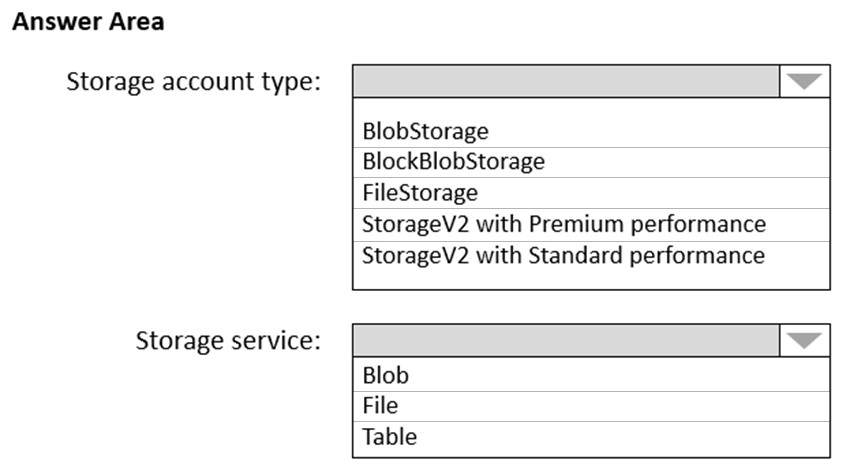
Correct Answer: 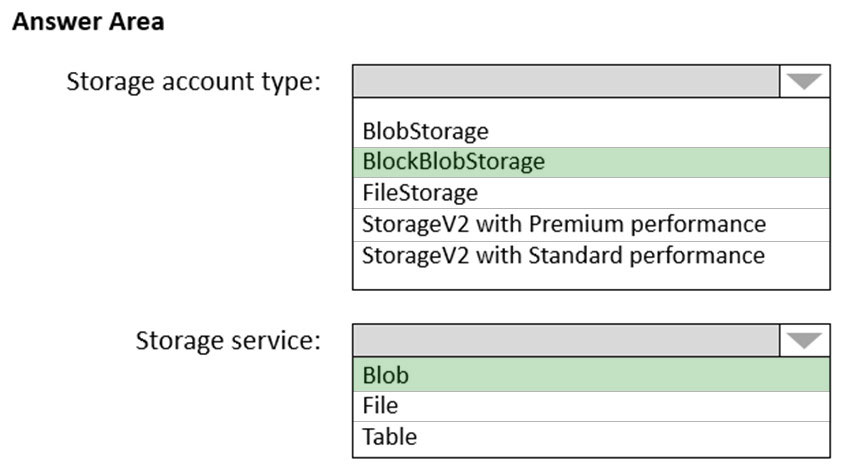
Box 1: BlockBlobStorage –
Block Blob is a premium storage account type for block blobs and append blobs. Recommended for scenarios with high transactions rates, or scenarios that use smaller objects or require consistently low storage latency.
Box 2: Blob –
The Archive tier is an offline tier for storing blob data that is rarely accessed. The Archive tier offers the lowest storage costs, but higher data retrieval costs and latency compared to the online tiers (Hot and Cool). Data must remain in the Archive tier for at least 180 days or be subject to an early deletion charge.
Reference:
https://docs.microsoft.com/en-us/azure/storage/blobs/archive-blob
Question #5Topic 2
HOTSPOT –
You have an Azure subscription that contains the storage accounts shown in the following table.
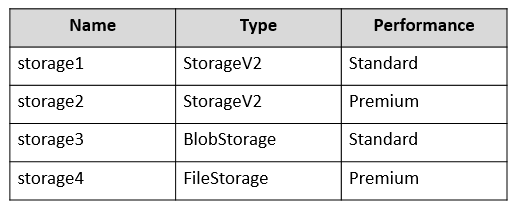
You plan to implement two new apps that have the requirements shown in the following table.

Which storage accounts should you recommend using for each app? To answer, select the appropriate options in the answer area.
NOTE: Each correct selection is worth one point.
Hot Area:
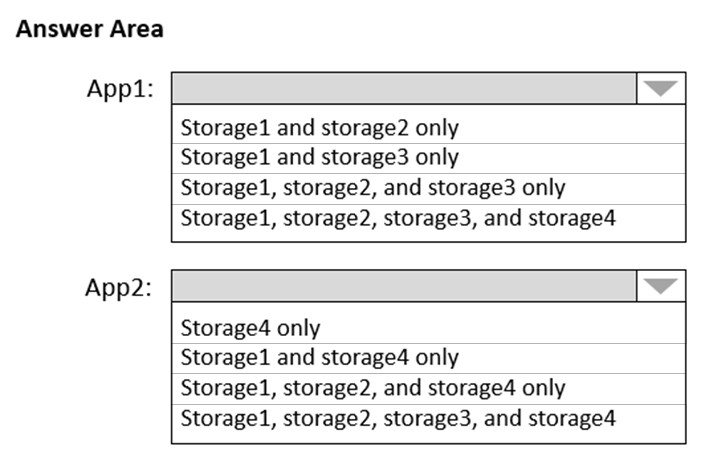
Correct Answer: 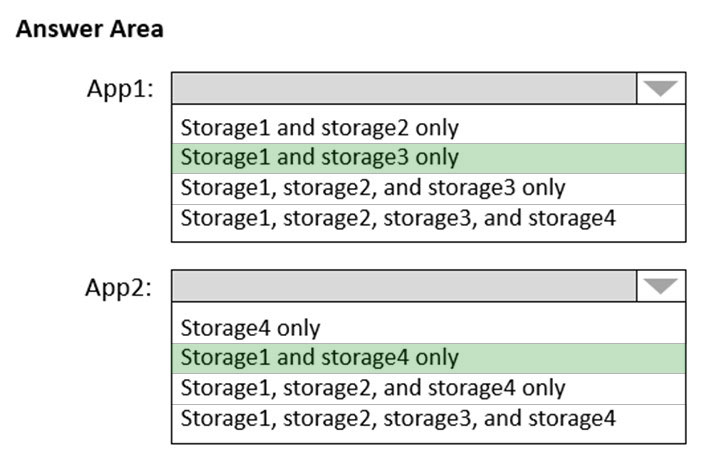
Box 1: Storage1 and storage3 only
Need to use Standard accounts.
Data stored in a premium block blob storage account cannot be tiered to hot, cool, or archive using Set Blob Tier or using Azure Blob Storage lifecycle management
Box 2: Storage1 and storage4 only
Azure File shares requires Premium accounts. Only Storage1 and storage4 are premium.
Reference:
https://docs.microsoft.com/en-us/azure/storage/blobs/access-tiers-overview#feature-support https://docs.microsoft.com/en-us/azure/storage/files/storage-how-to-create-file-share?tabs=azure-portal#basics
Question #6Topic 2
You are designing an application that will be hosted in Azure.
The application will host video files that range from 50 MB to 12 GB. The application will use certificate-based authentication and will be available to users on the internet.
You need to recommend a storage option for the video files. The solution must provide the fastest read performance and must minimize storage costs.
What should you recommend?
- A. Azure Files
- B. Azure Data Lake Storage Gen2
- C. Azure Blob Storage
- D. Azure SQL Database
Correct Answer: C
Blob Storage: Stores large amounts of unstructured data, such as text or binary data, that can be accessed from anywhere in the world via HTTP or HTTPS. You can use Blob storage to expose data publicly to the world, or to store application data privately.
Max file in Blob Storage. 4.77 TB.
Reference:
https://docs.microsoft.com/en-us/azure/architecture/solution-ideas/articles/digital-media-video
Community vote distribution
C (100%)
Question #7Topic 2
You are designing a SQL database solution. The solution will include 20 databases that will be 20 GB each and have varying usage patterns.
You need to recommend a database platform to host the databases. The solution must meet the following requirements:
✑ The solution must meet a Service Level Agreement (SLA) of 99.99% uptime.
✑ The compute resources allocated to the databases must scale dynamically.
✑ The solution must have reserved capacity.
Compute charges must be minimized.
![]()
What should you include in the recommendation?
- A. an elastic pool that contains 20 Azure SQL databases
- B. 20 databases on a Microsoft SQL server that runs on an Azure virtual machine in an availability set
- C. 20 databases on a Microsoft SQL server that runs on an Azure virtual machine
- D. 20 instances of Azure SQL Database serverless
Correct Answer: A
The compute and storage redundancy is built in for business critical databases and elastic pools, with a SLA of 99.99%.
Reserved capacity provides you with the flexibility to temporarily move your hot databases in and out of elastic pools (within the same region and performance tier) as part of your normal operations without losing the reserved capacity benefit.
Reference:
Community vote distribution
A (100%)
Question #8Topic 2
HOTSPOT –
You have an on-premises database that you plan to migrate to Azure.
You need to design the database architecture to meet the following requirements:
✑ Support scaling up and down.
✑ Support geo-redundant backups.
✑ Support a database of up to 75 TB.
✑ Be optimized for online transaction processing (OLTP).
What should you include in the design? To answer, select the appropriate options in the answer area.
NOTE: Each correct selection is worth one point.
Hot Area:
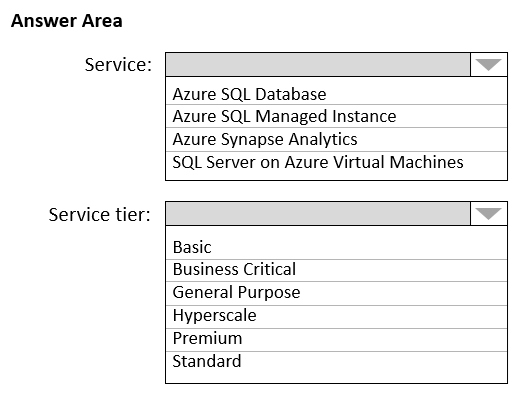
Correct Answer: 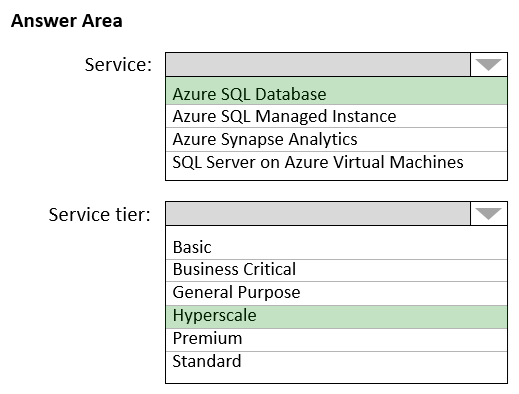
Box 1: Azure SQL Database –
Azure SQL Database:
Database size always depends on the underlying service tiers (e.g. Basic, Business Critical, Hyperscale).
It supports databases of up to 100 TB with Hyperscale service tier model.
Active geo-replication is a feature that lets you to create a continuously synchronized readable secondary database for a primary database. The readable secondary database may be in the same Azure region as the primary, or, more commonly, in a different region. This kind of readable secondary databases are also known as geo-secondaries, or geo-replicas.
Azure SQL Database and SQL Managed Instance enable you to dynamically add more resources to your database with minimal downtime.
Box 2: Hyperscale –
Incorrect Answers:
✑ SQL Server on Azure VM: geo-replication not supported.
✑ Azure Synapse Analytics is not optimized for online transaction processing (OLTP).
✑ Azure SQL Managed Instance max database size is up to currently available instance size (depending on the number of vCores).
Max instance storage size (reserved) – 2 TB for 4 vCores
– 8 TB for 8 vCores
– 16 TB for other sizes
Reference:
https://docs.microsoft.com/en-us/azure/azure-sql/database/active-geo-replication-overview https://medium.com/awesome-azure/azure-difference-between-azure-sql-database-and-sql-server-on-vm-comparison-azure-sql-vs-sql-server-vm-cf02578a1188
Question #9Topic 2
You are planning an Azure IoT Hub solution that will include 50,000 IoT devices.
Each device will stream data, including temperature, device ID, and time data. Approximately 50,000 records will be written every second. The data will be visualized in near real time.
You need to recommend a service to store and query the data.
Which two services can you recommend? Each correct answer presents a complete solution.
NOTE: Each correct selection is worth one point.
- A. Azure Table Storage
- B. Azure Event Grid
- C. Azure Cosmos DB SQL API
- D. Azure Time Series Insights
Correct Answer: CD
D: Time Series Insights is a fully managed service for time series data. In this architecture, Time Series Insights performs the roles of stream processing, data store, and analytics and reporting. It accepts streaming data from either IoT Hub or Event Hubs and stores, processes, analyzes, and displays the data in near real time.
C: The processed data is stored in an analytical data store, such as Azure Data Explorer, HBase, Azure Cosmos DB, Azure Data Lake, or Blob Storage.
Reference:
https://docs.microsoft.com/en-us/azure/architecture/data-guide/scenarios/time-series
Community vote distribution
CD (88%)

